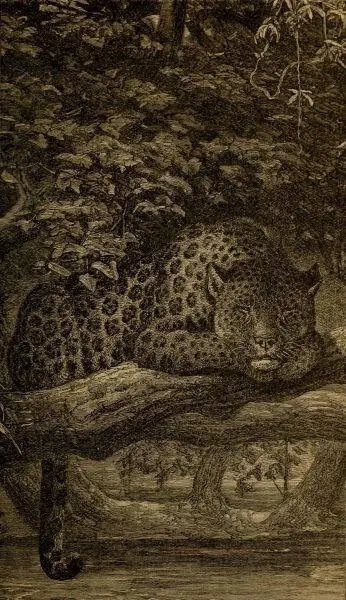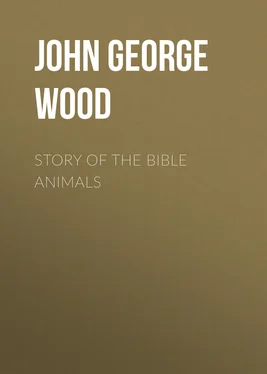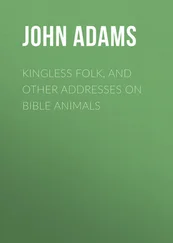John George Wood - Story of the Bible Animals
Здесь есть возможность читать онлайн «John George Wood - Story of the Bible Animals» — ознакомительный отрывок электронной книги совершенно бесплатно, а после прочтения отрывка купить полную версию. В некоторых случаях можно слушать аудио, скачать через торрент в формате fb2 и присутствует краткое содержание. Жанр: foreign_prose, foreign_religion, Философия, foreign_psychology, foreign_antique, на английском языке. Описание произведения, (предисловие) а так же отзывы посетителей доступны на портале библиотеки ЛибКат.
- Название:Story of the Bible Animals
- Автор:
- Жанр:
- Год:неизвестен
- ISBN:нет данных
- Рейтинг книги:4 / 5. Голосов: 1
-
Избранное:Добавить в избранное
- Отзывы:
-
Ваша оценка:
- 80
- 1
- 2
- 3
- 4
- 5
Story of the Bible Animals: краткое содержание, описание и аннотация
Предлагаем к чтению аннотацию, описание, краткое содержание или предисловие (зависит от того, что написал сам автор книги «Story of the Bible Animals»). Если вы не нашли необходимую информацию о книге — напишите в комментариях, мы постараемся отыскать её.
Story of the Bible Animals — читать онлайн ознакомительный отрывок
Ниже представлен текст книги, разбитый по страницам. Система сохранения места последней прочитанной страницы, позволяет с удобством читать онлайн бесплатно книгу «Story of the Bible Animals», без необходимости каждый раз заново искать на чём Вы остановились. Поставьте закладку, и сможете в любой момент перейти на страницу, на которой закончили чтение.
Интервал:
Закладка:
As is the case with most of the cat tribe, the Leopard is an excellent climber, and can ascend trees and traverse their boughs without the least difficulty. It is so fond of trees, that it is seldom to be seen except in a well-wooded district. Its favourite residence is a forest where there is plenty of underwood, at least six or seven feet in height, among which trees are sparingly interspersed. When crouched in this cover it is practically invisible, even though its body may be within arm's length of a passenger. The spotted body harmonizes so perfectly with the broken lights and deep shadows of the foliage that even a practised hunter will not enter a covert in search of a Leopard unless he is accompanied by dogs. The instinct which teaches the Leopard to choose such localities is truly wonderful, and may be compared with that of the tiger, which cares little for underwood, but haunts the grass jungles, where the long, narrow blades harmonize with the stripes which decorate its body.

WAITING.
The skin of the Leopard has always been highly valued on account of its beauty, and in Africa, at the present day, a robe made of its spotted skin is as much an adjunct of royalty as is the ermine the emblem of judicial dignity in England. In more ancient times, a leopard skin was the official costume of a priest, the skin being sometimes shaped into a garment, and sometimes thrown over the shoulders and the paws crossed over the breast.
Such is a general history of the Leopard. We will now proceed to the various passages in which it is mentioned, beginning with its outward aspect.
In the first place, the Hebrew word Namer signifies "spotted," and is given to the animal in allusion to its colours. The reader will now see how forcible is the lament of Jeremiah, "Can the Ethiopian change his skin, or the Leopard his spots?" Literally, "Can the Ethiopian change his skin, or the spotted one his spots?"
The agility and swiftness of the Leopard are alluded to in the prediction by the prophet Habakkuk of the vengeance that would come upon Israel through the Chaldeans. In chap. i. 5, we read: "I will work a work in your days, which ye will not believe though it be told you. For, lo, I raise up the Chaldeans, that bitter and hasty nation, which shall march through the breadth of the land, to possess the dwelling-places that are not theirs. They are terrible and dreadful; their judgment and their dignity shall proceed of themselves. Their horses also are swifter than the Leopards, and are more fierce than the evening wolves."
The craftiness of the Leopard, and the manner in which it lies in wait for its prey, are alluded to in more than one passage of Holy Writ. Hosea the prophet alludes to the Leopard in a few simple words which display an intimate acquaintance with the habits of this formidable animal, and in this part of his prophecies he displays that peculiar local tone which distinguishes his writings. Speaking of the Israelites under the metaphor of a flock, or a herd, he proceeds to say: "According to their pasture so were they filled; they were filled, and their heart was exalted; therefore have they forgotten me. Therefore I will be unto them as a lion, as a Leopard by the way will I observe them." The reader will note the peculiar force of this sentence, whereby God signifies that He will destroy them openly, as a lion rushes on its prey, and that he will chastise them unexpectedly, as if it were a Leopard crouching by the wayside, and watching for the flock to pass, that it may spring on its prey unexpectedly. The same habit of the Leopard is also alluded to by Jeremiah, who employs precisely the same imagery as is used by Habakkuk. See Jer. v. 5, 6, "These have altogether broken the yoke, and burst the bonds. Wherefore a lion out of the forest shall slay them, and a wolf of the evenings shall spoil them, a leopard shall watch over their cities." It is evident from the employment of this image by two prophets, the one being nearly a hundred years before the other, that the crafty, insidious habits of the Leopard were well known in Palestine, and that the metaphor would tell with full force among those to whom it was addressed.
THE CAT
The Cat never mentioned by name in the canonical Scriptures, and only once in the Apocrypha—The Cat domesticated among the Egyptians, and trained in bird-catching—Neglected capabilities of the Cat—Anecdote of an English Cat that caught fish for her master—Presumed reason why the Scriptures are silent about the Cat—The Cat mentioned by Baruch.
It is a very remarkable circumstance that the word Cat is not once mentioned in the whole of the canonical Scriptures, and only once in the Apocrypha.
The Egyptians, as is well known, kept Cats domesticated in their houses, a fact which is mentioned by Herodotus, in his second book, and the 66th and 67th chapters. After describing the various animals which were kept and fed by this nation, he proceeds to narrate the habits of the Cat, and writes as follows: "When a fire takes place, a supernatural impulse seizes the cats. For the Egyptians, standing at a distance, take care of the cats and neglect to quench the fire; but the cats make their escape, and leaping over the men, cast themselves into the fire, and when this occurs, great lamentations are made among the Egyptians. In whatever house a cat dies of a natural death, all the family shave their eyebrows. All cats that die are carried to certain sacred houses, where, after being embalmed, they are buried in the city of Bubastis."
Now, as many of those cat-mummies have been discovered in good preservation, the species has been identified with the Egyptian Cat of the present day, which is scientifically termed Felis maniculatus . Not only did the Egyptians keep Cats at their houses, but, as is shown by certain sculptures, took the animals with them when they went bird-catching, and employed them in securing their prey. Some persons have doubted this statement, saying, that in the first place, the Cat is not possessed of sufficient intelligence for the purpose; and that in the second place, as the hunter is represented as catching wild fowl, the Cat would not be able to assist him, because it would not enter the water. Neither objection is valid, nor would have been made by a naturalist.
There are no grounds whatever for assuming that the Cat has not sufficient intelligence to aid its master in hunting. On the contrary, there are many familiar instances where the animal has been trained, even in this country, to catch birds and other game, and bring its prey home. By nature the Cat is an accomplished hunter, and, like other animals of the same disposition, can be taught to use its powers for mankind. We all know that the chetah, a member of the same tribe, is in constant use at the present day, and we learn from ancient sculptures that the lion was employed for the same purpose. Passing from land to water, mankind has succeeded in teaching the seal and the otter to plunge into the water, catch their finny prey, and deliver it to their owners. Among predaceous birds, we have trained the eagle, the falcon, and various hawks, to assist us in hunting the finned and feathered tribes, while we have succeeded in teaching the cormorant to catch fish for its master, and not for itself. Why, then, should the Cat be excepted from a rule so general? The fact is, the Cat has been, although domesticated for so many centuries, a comparatively neglected animal; and it is the fashion to heap upon it the contumacious epithets of sullen, treacherous, selfish, spiteful, and intractable, just as we take as our emblems of stupidity the ass and the goose, which are really among the most cunning of the lower animals. We have never tried to teach the Cat the art of hunting for her owners, but that is no reason for asserting that the animal could not be taught.
Читать дальшеИнтервал:
Закладка:
Похожие книги на «Story of the Bible Animals»
Представляем Вашему вниманию похожие книги на «Story of the Bible Animals» списком для выбора. Мы отобрали схожую по названию и смыслу литературу в надежде предоставить читателям больше вариантов отыскать новые, интересные, ещё непрочитанные произведения.
Обсуждение, отзывы о книге «Story of the Bible Animals» и просто собственные мнения читателей. Оставьте ваши комментарии, напишите, что Вы думаете о произведении, его смысле или главных героях. Укажите что конкретно понравилось, а что нет, и почему Вы так считаете.












